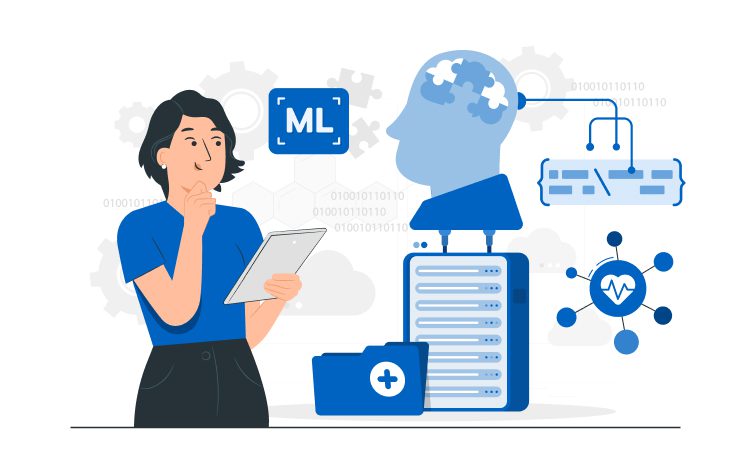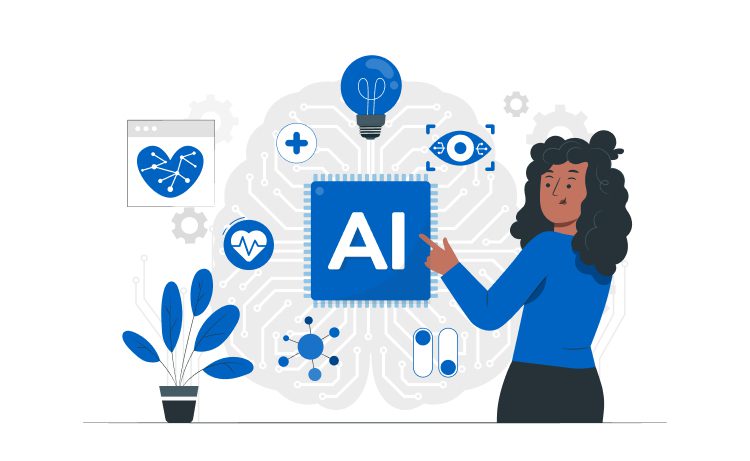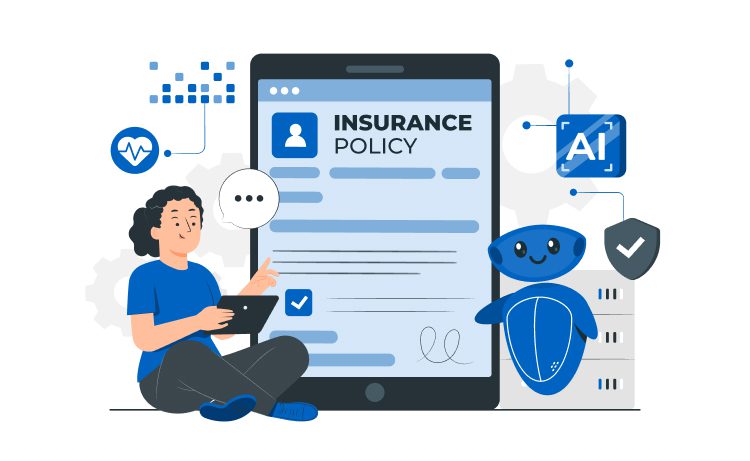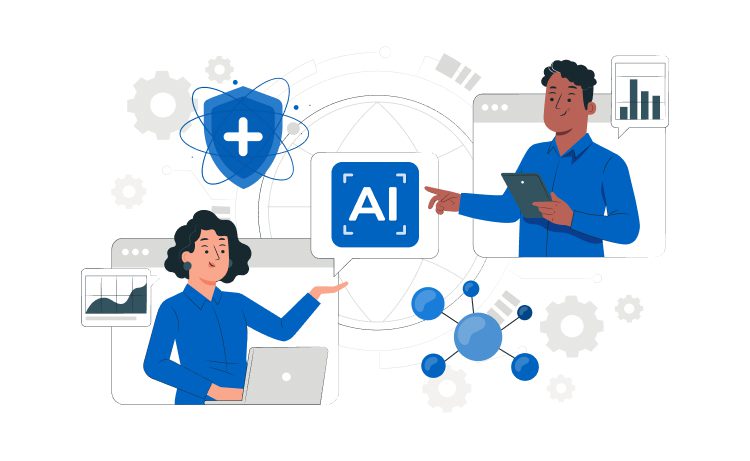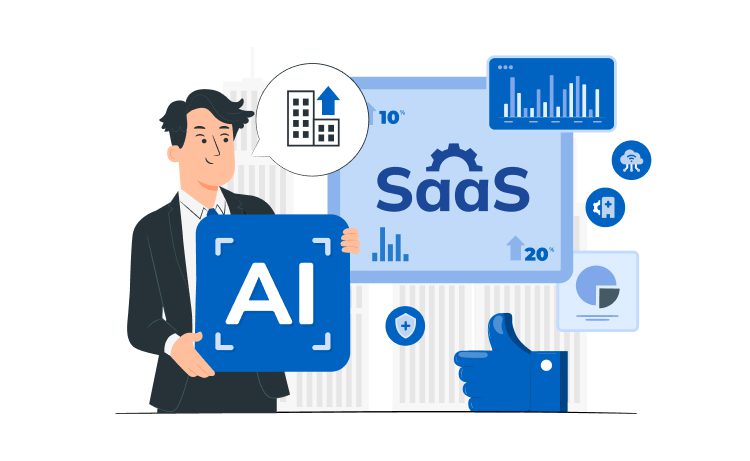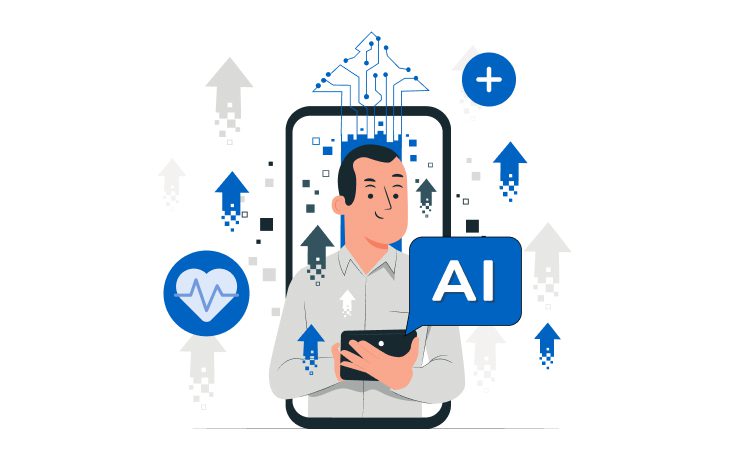
The Potential for AI in Healthcare



The Glorium Technologies curated report aims to provide healthcare startups and companies with a comprehensive overview of the role of AI in the industry, complete with valuable statistics and insights.
Throughout our journey at Glorium Technologies, we’ve always believed in the transformative power of technology and its ability to address unique business challenges.
The dawn of Artificial Intelligence has ushered in an era of unprecedented potential. It’s not just another technology; it’s a paradigm shift. At Glorium Technologies, we are perfectly positioned with our 13 years expertise and insights to integrate AI seamlessly into new and existing projects. We understand the nuances, the challenges, and, most importantly, the immense possibilities that AI brings.
Andrei KasyanauCEO and Co-Founder, Glorium Technologies
Content
For healthcare startups and established companies alike, integrating AI presents many benefits and untapped opportunities. Leveraging AI can significantly reduce operational costs by automating routine tasks, optimizing patient scheduling, and refining administrative processes. Furthermore, AI-powered predictive analytics can help forecast patient admissions, resource utilization, and even potential disease outbreaks, allowing institutions to be better prepared.
The global AI market is expected to grow exponentially in the next few years, with predictions ranging from $173.55 billion to $187.95 billion by 2030.
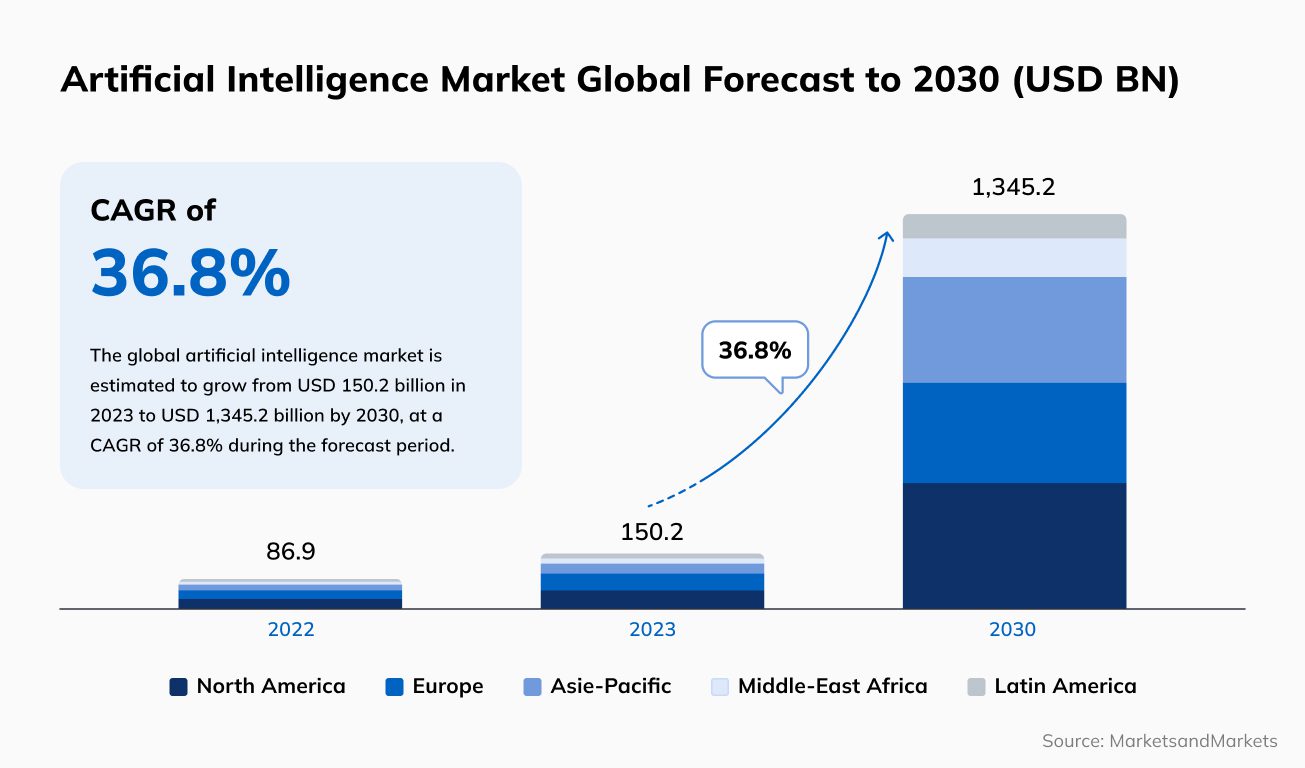
The AI market globally was estimated at USD 150.2 billion in 2023 and is predicted to increase in numbers at a CAGR of 36.8% from 2023 to 2030. (Source: MarketsandMarkets)
The AI industry is witnessing rapid growth, with trends suggesting a sustained increase for years. This growth surge is attributed to multiple factors, including the rise in data accessibility, cutting-edge advancements in computer technology, and the burgeoning interest in AI solutions across diverse industries.

Here’s a breakdown of the primary factors driving the AI market’s:
AI could potentially create $3.5 trillion to $5.8 trillion in annual revenue in the global economy. In the report it was estimated a range of annual value to the global economy for both AI and other analytics techniques, based on the value we observed being created in current use cases and the potential value in projected future ones.
The possible annual value of AI in 19 different industries and nine business functions globally ranges from $3.5 trillion to $5.8 trillion. This makes up approximately 40% of the total potential impact of all analytical techniques, which could be between $9.5 trillion to $15.4 trillion per year.

AI market size in healthcare represents a dynamic and rapidly evolving segment, reflecting the intersection of technological innovation and medical care. As AI continues to advance, its applications within healthcare are expanding, profoundly influencing not just medical practices but also the economics of the healthcare sector. A combination of technological breakthroughs fuels this growth in AI within healthcare, increasing healthcare data availability, and a growing emphasis on personalized and efficient patient care.
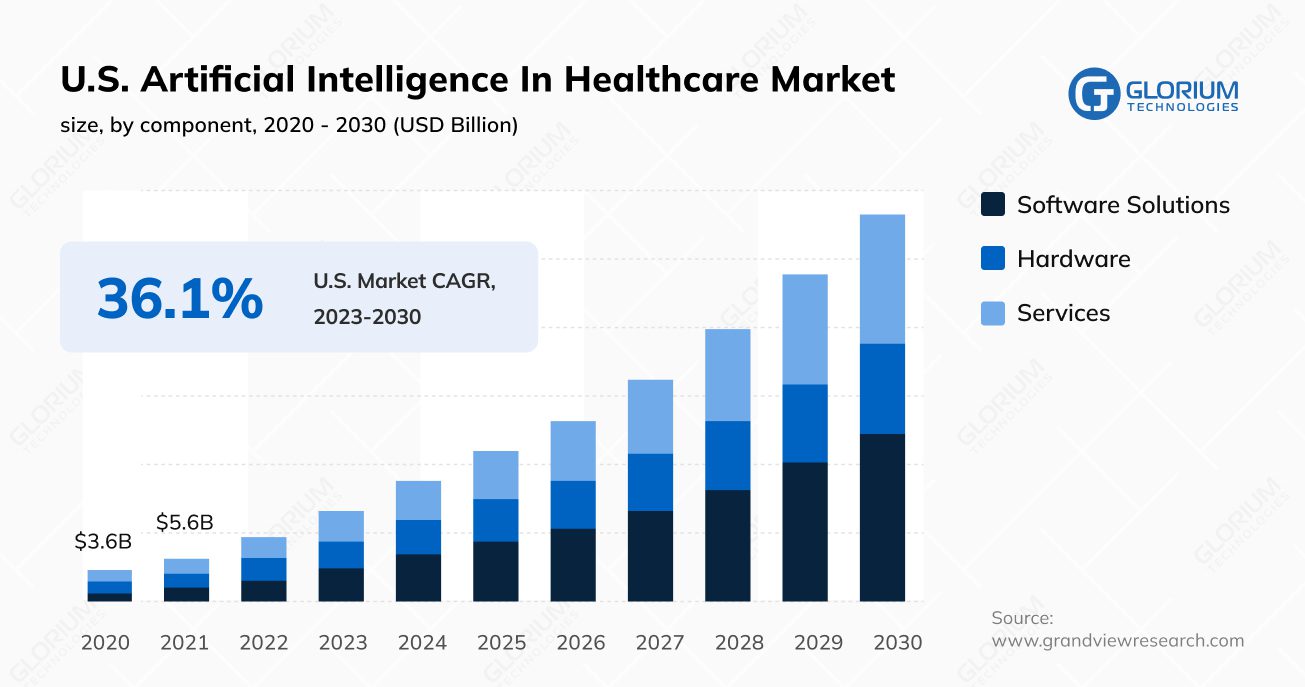
North America is currently leading the healthcare AI market, followed by Europe and Asia Pacific. (Allied Market Research)

The European AI healthcare sector is on the brink of substantial expansion, with market valuations anticipated to climb from USD 2.6 billion in 2022 to a remarkable USD 10.8 billion by 2028, showcasing a CAGR of 40.2%. (Source: MarketsandMarkets)
Predictions highlight a significant enlargement in the Asia-Pacific region’s AI healthcare market from 2022 to 2028, escalating from USD 2.3 billion to an estimated USD 9.2 billion, with a CAGR of 43.7%. (Source: MarketsandMarkets)
Similarly, the Middle East and Africa’s AI healthcare market is set on a rising curve, with forecasts showing an ascent from USD 0.3 billion in 2022 to a potential USD 1.5 billion by 2028, denoting a CAGR of 42.5%. (Source: MarketsandMarkets)

The number of AI-powered healthcare startups is on the rise, with over 4,000 such startups worldwide as of 2021. This figure is projected to reach over 10,000 by 2025, indicating a significant growth trend in the industry. (Source: CB Insights)
According to the ACK Data Science Institute, a US-based organization involved in developing a framework for the implementation of machine learning in radiology, about 30% of radiologists in current practice use AI clinically to enhance the radiology imaging process as of July 2022.
According to multiple studies among 1000 respondents, around 65% of business-related people (CEO, CTO, founders, etc.) have already heard about AI.
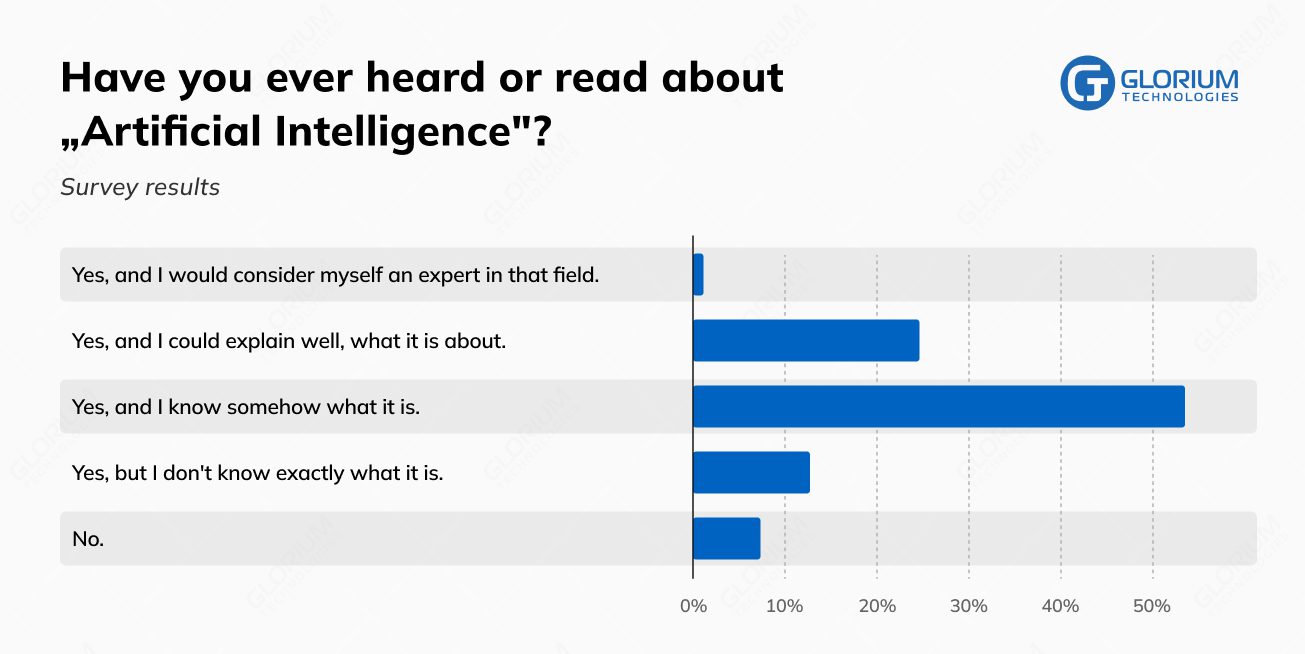
According to the study of McKinsey:
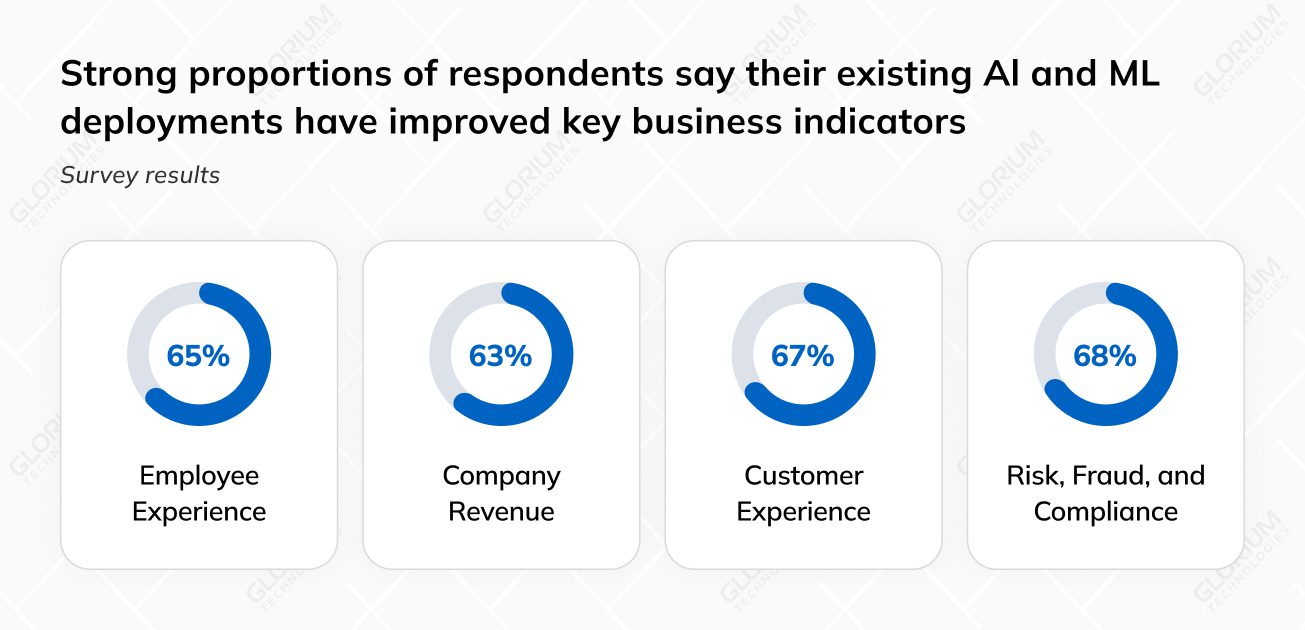
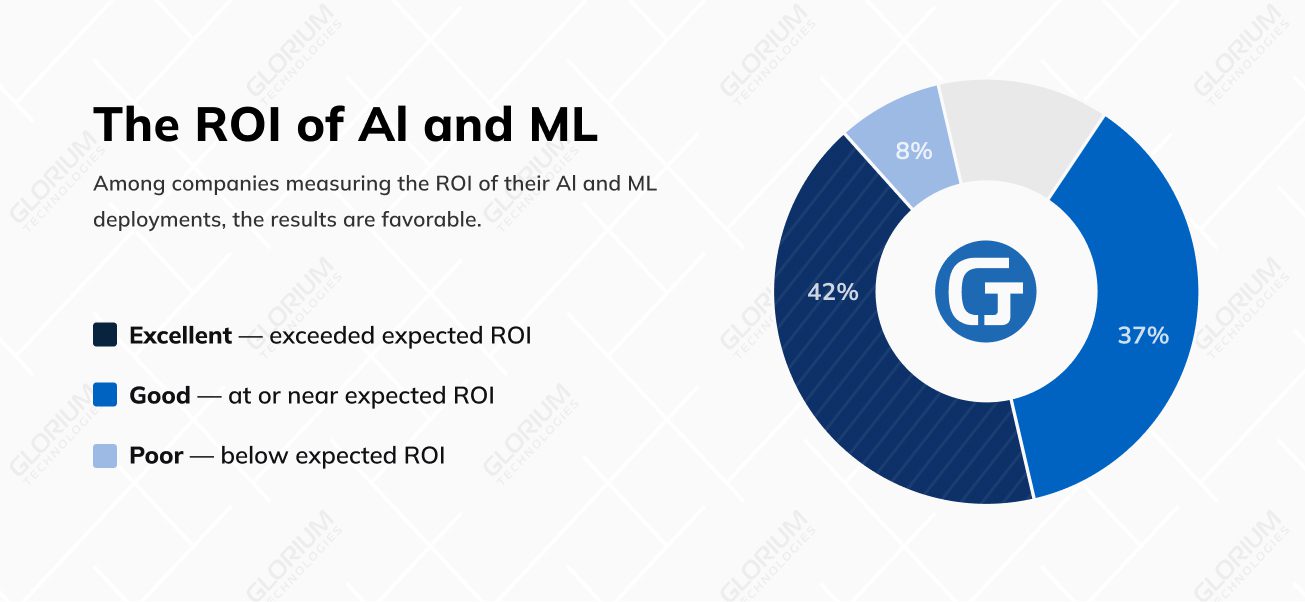
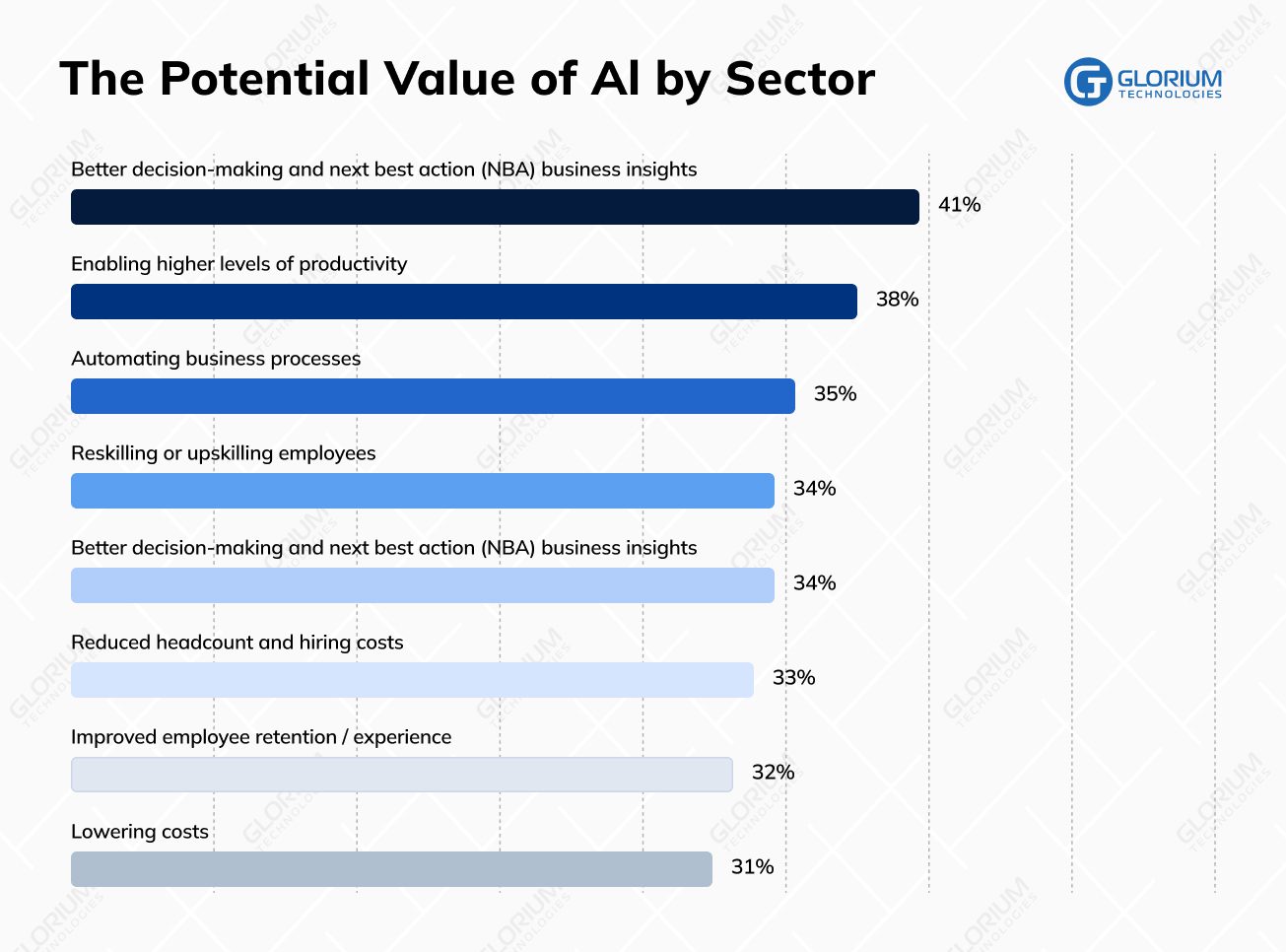
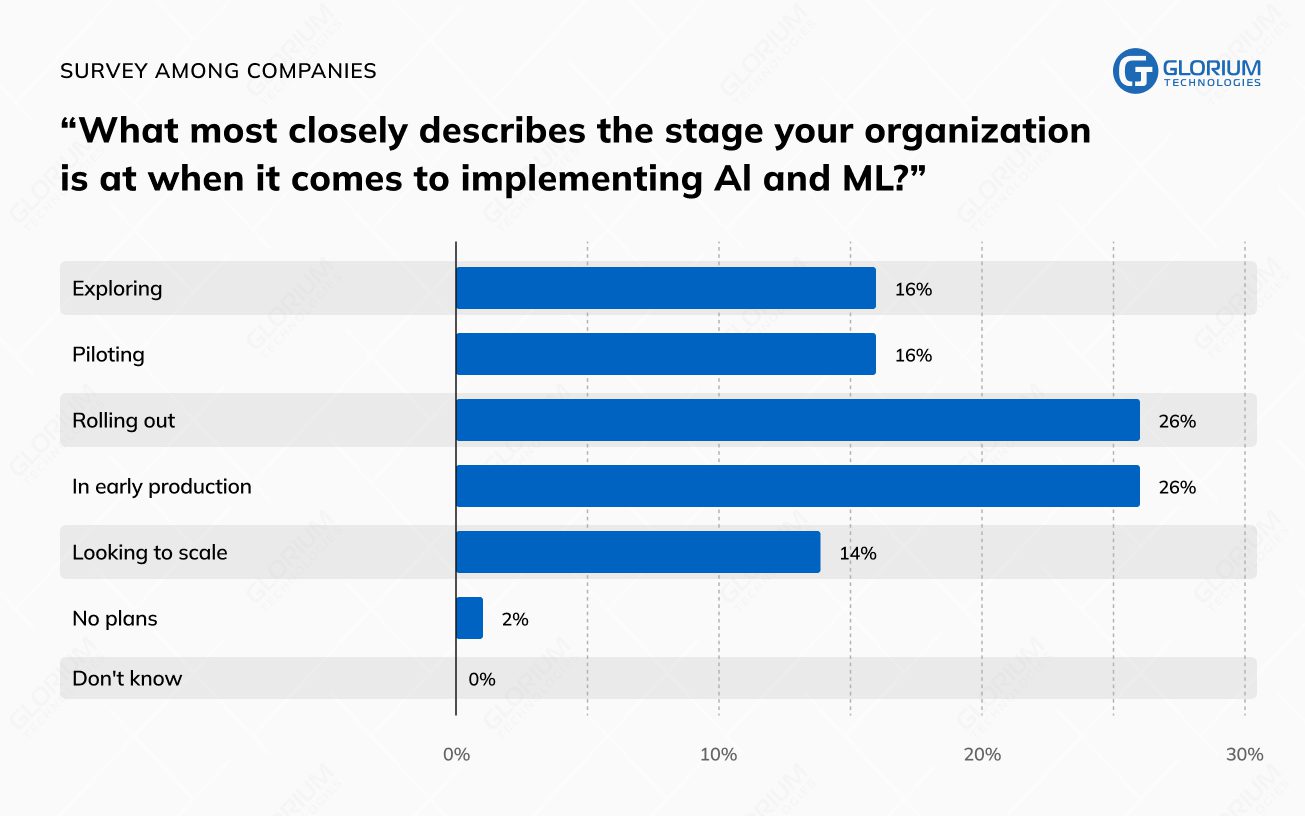
As per the CBI study, it has been found that tech giants are already utilizing AI in healthcare. Moreover, universities and companies are also employing AI to create health apps.

Microsoft has been collaborating with pharma partners like Novo Nordisk, Novartis, and USB Pharma to discover drugs using AI implementation since 2019.
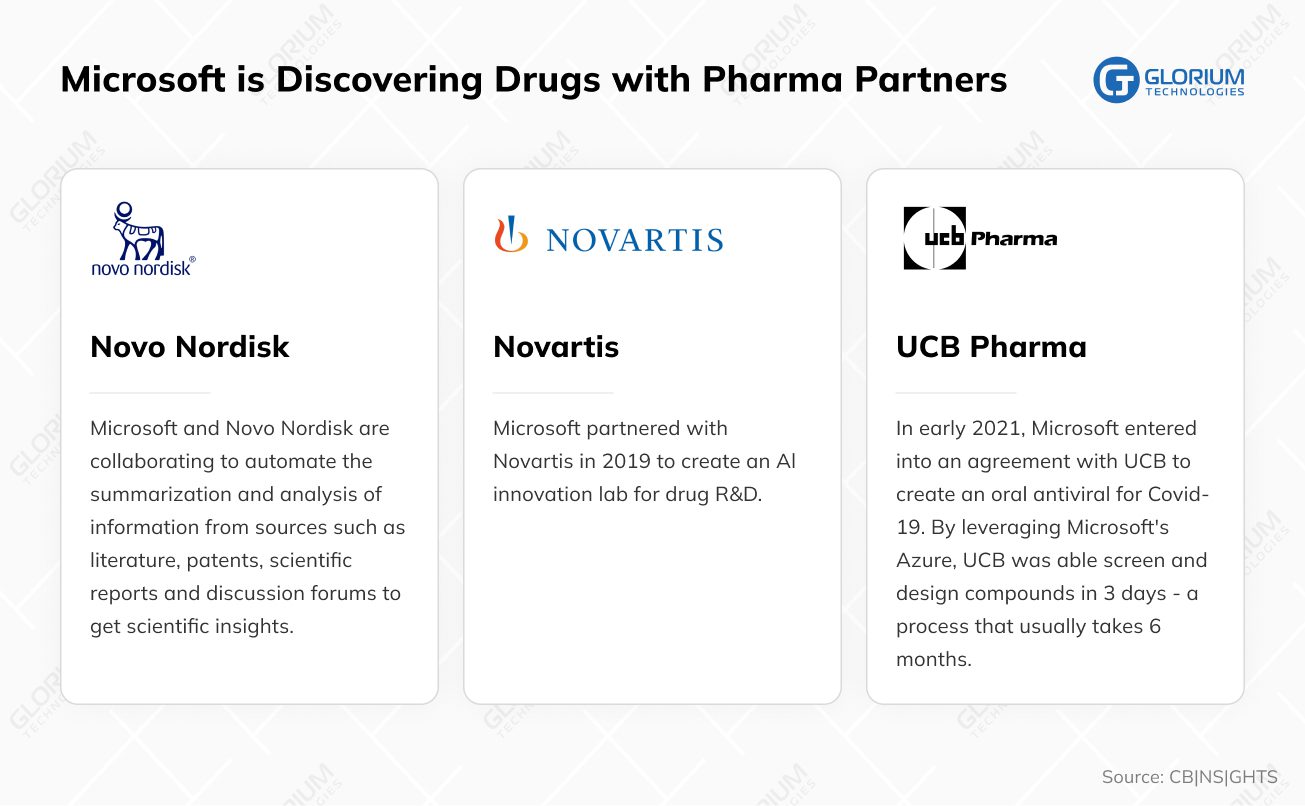
Apple is dedicated to facilitating health monitoring with the help of Apple Watch and intends to utilize machine learning and artificial intelligence technologies.
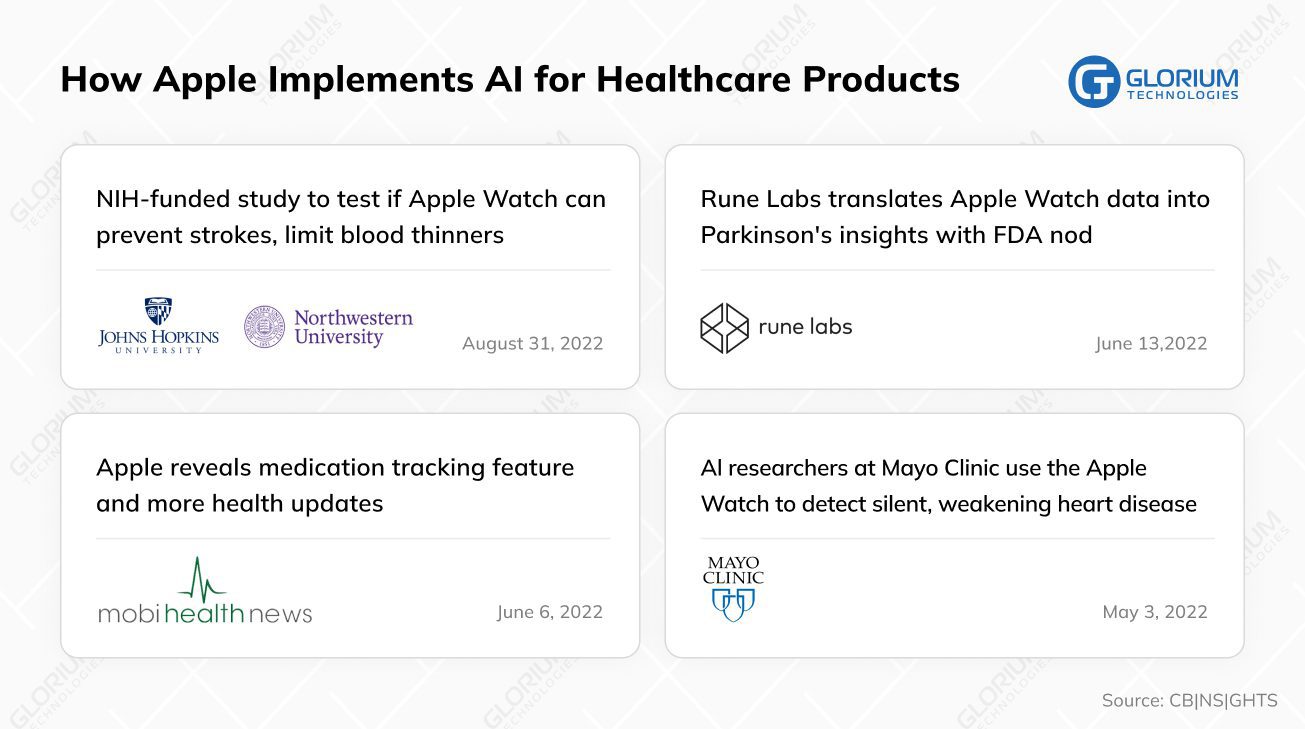
Interest in digital biomarkers has been growing since 2018, with many companies exploring how to utilize machine learning and artificial intelligence technologies to facilitate health monitoring.
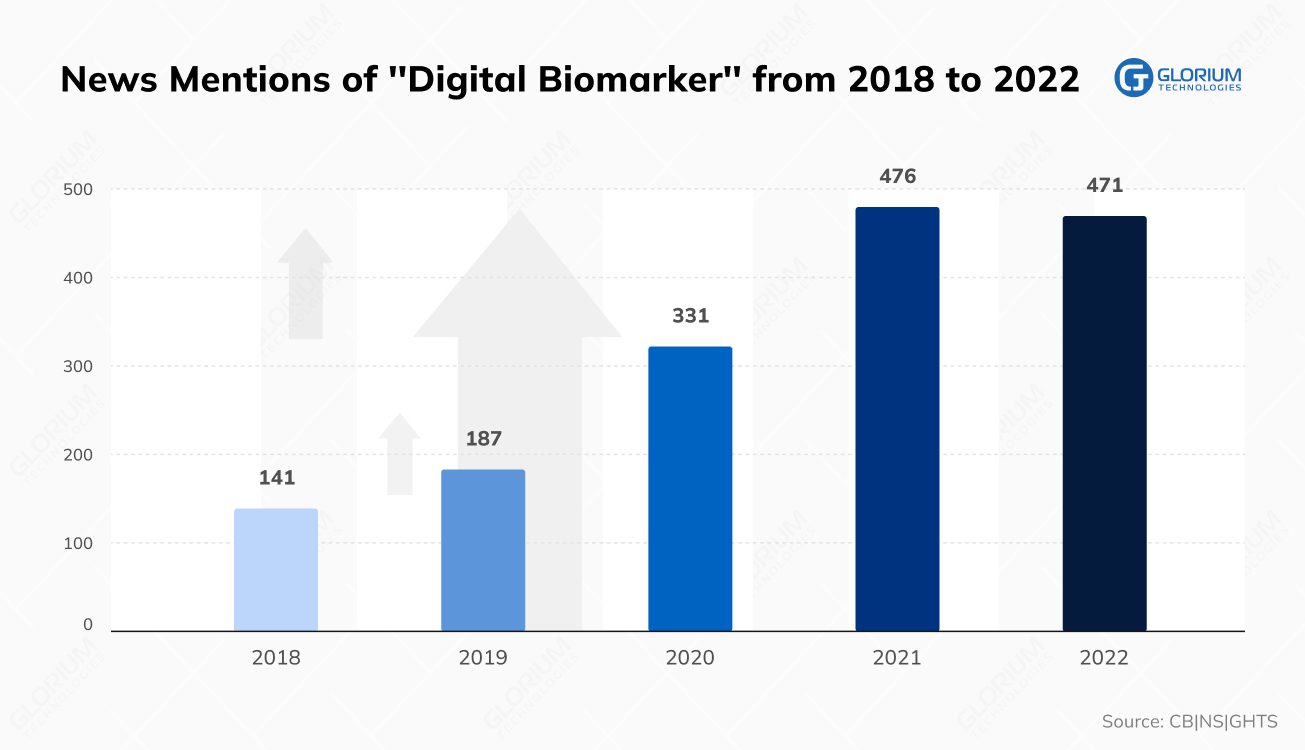
In 2021, it was reported that Apple has initiated a study to develop digital biomarkers for cognitive health.

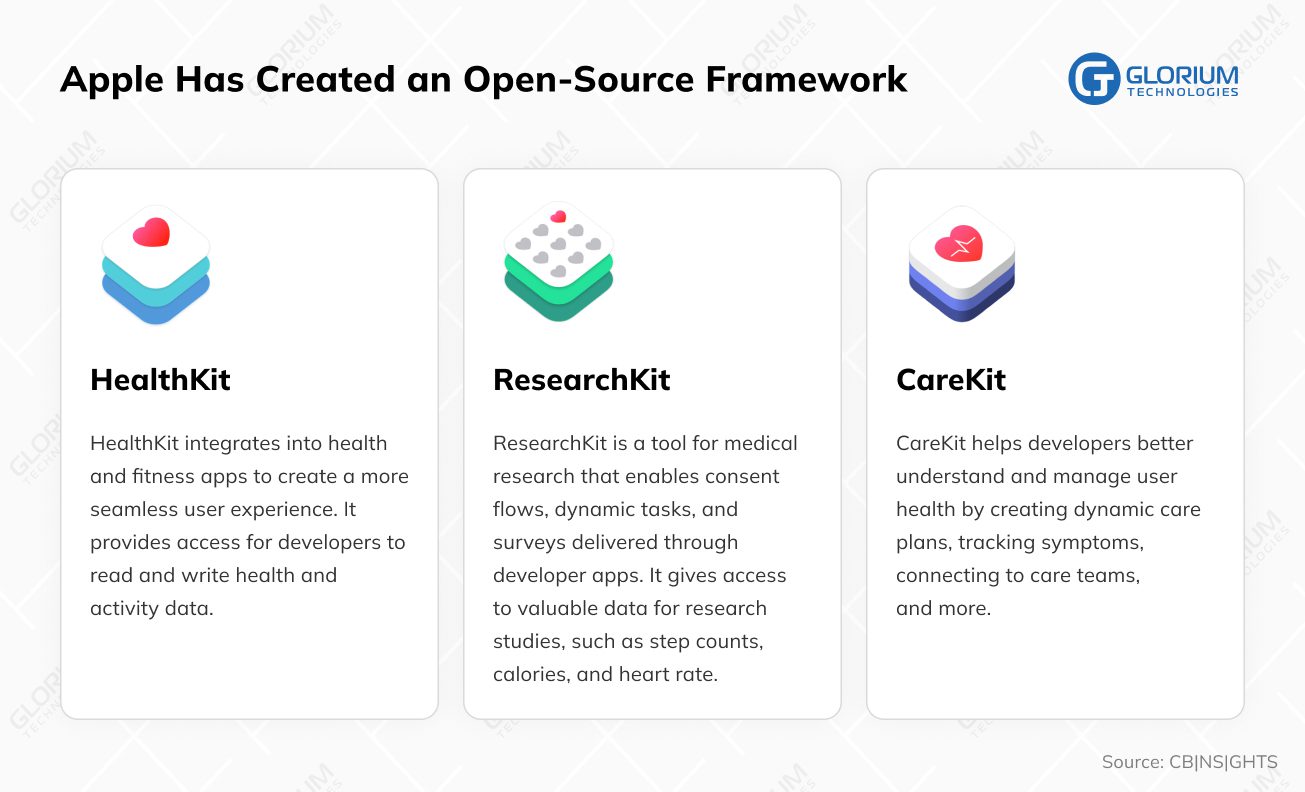
Calico Life Sciences, a subsidiary of Alphabet, has announced a partnership to develop drugs that focus on anti-aging.
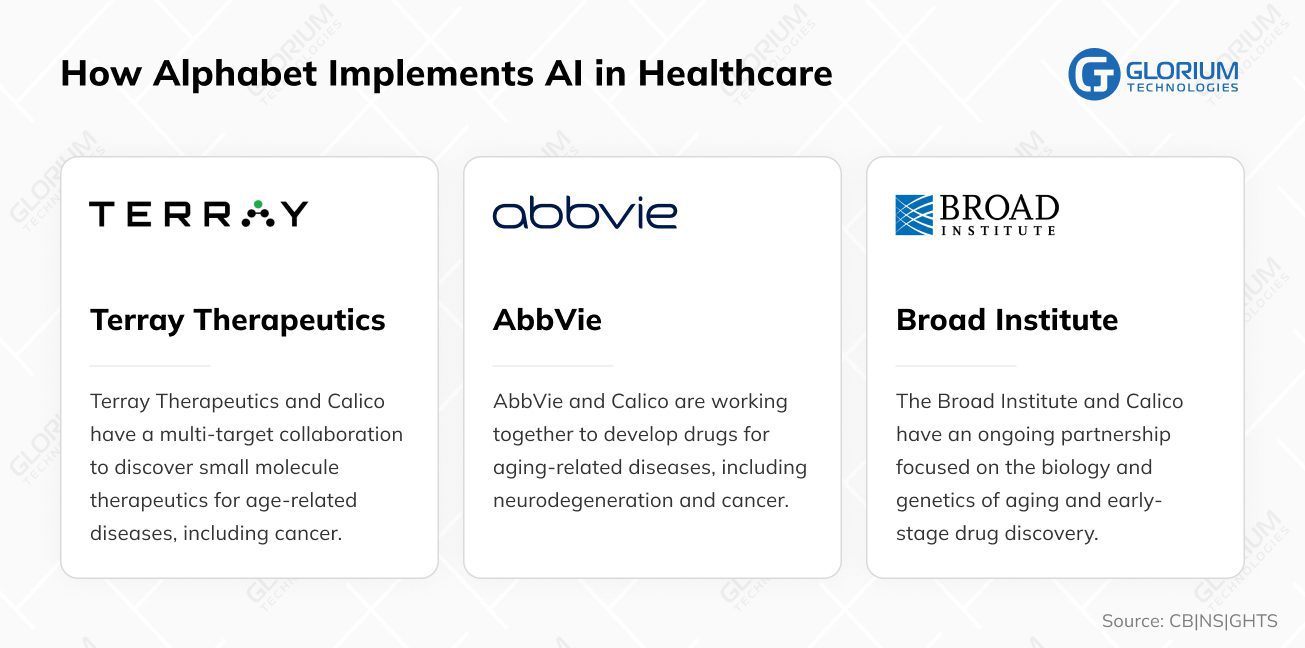
Alphabet is currently concentrating its efforts on various fields such as AI, healthcare interoperability, hardware development, and drug discovery.
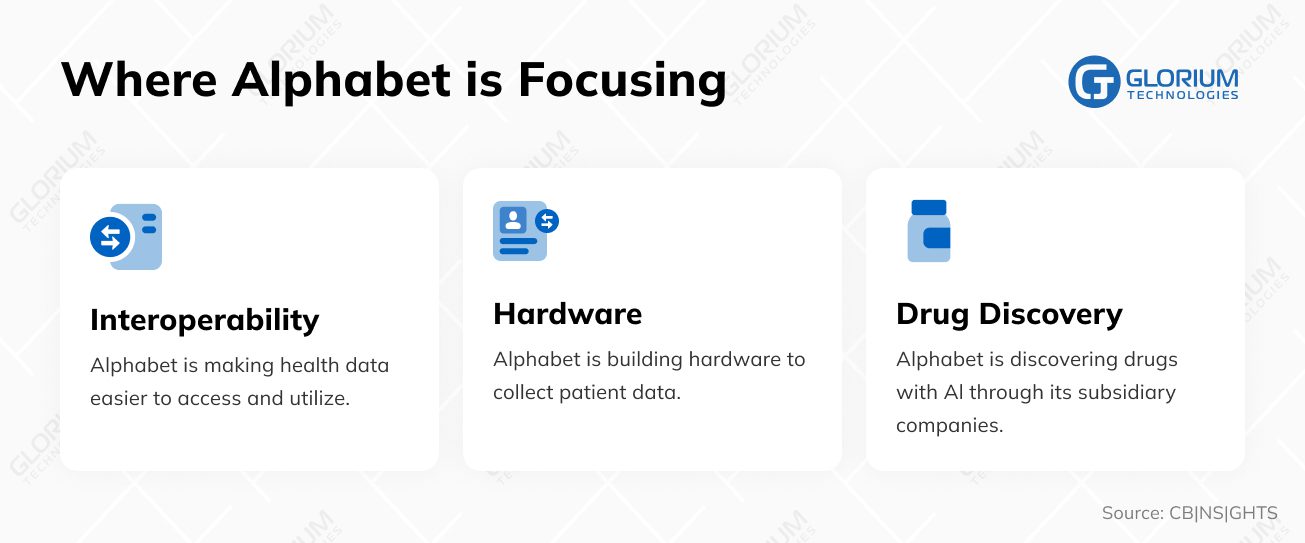



Alphabet is investing in the development of remote patient monitoring hardware and software that utilizes AI technology.
Results of a recent survey conducted by Workday revealed that 98% of business leaders, including CEOs, CFOs, CIOs, and CHROs, believe that implementing AI and machine learning (ML) capabilities will have immediate business benefits. However, 43% of CEOs expressed concern about the trustworthiness of these technologies.

The survey also showed that 67% of CEOs identified potential errors as a top risk associated with integrating AI and ML into their organizations, which reinforces their lack of trust. To build trust in AI, increased transparency is necessary, according to Workday. The survey also highlighted that 59% of organizations reported that their data is either somewhat or completely siloed, which is obscuring business leaders’ ability to lean into these technologies.
Despite these concerns, 47% of business leaders believe that AI and ML will significantly amplify human potential, and 71% said that the global business landscape will be affected by these technologies in the next three years. The top benefits of implementing AI and ML include increased productivity, data-driven decision-making, and improved collaboration, according to the survey.
However, 49% of CEOs feel that their organizations are unprepared to adopt these technologies due to a lack of necessary tools, skills, and knowledge. Furthermore, 28% of CEOs want to wait and see how AI and ML affect their organization before determining their approach. Among CEOs, 30% expressed concern that employees will struggle to keep up with rapid changes as AI and ML become more integrated into their organization.
Additionally, 32% of HR and finance leaders worry that their teams will not have the technical skills needed to work effectively with these technologies. Despite these concerns, 45% of CEOs believe that AI and ML will create a more equitable and diverse workforce, and 39% believe the biggest potential benefit is increased productivity, showing the critical connection between technology and human potential.
According to a recent survey of 791 psychiatrists mostly from developed countries, 83% believe that future technology is unlikely to provide empathetic care, and only 3.8% feel that it would make their jobs obsolete. In a separate study, 77% of radiologists reported favorable attitudes towards adopting AI, with 89% not being afraid of job loss. Pathologists also showed high acceptance of AI, with only 17.6% expressing concern about future job security. Additionally, 60% of neurosurgeons reported using AI to predict outcomes, and in Germany, 90% of physicians from different specialties expect a future of medicine that combines human intelligence and AI.
Source: National Library of Medicine (articles)
The healthcare industry is undergoing a transformative phase, driven by ten key trends reshaping the medical care landscape, management, and innovation. These trends include healthcare analytics, medical diagnostics, telehealth, medical robots, hospital management, clinical decision support, clinical trials, public health management, personalized healthcare, and cybersecurity. Each trend carries a significant impact, collectively contributing to a more efficient, accessible, and customized healthcare system.

AI allows startups to achieve more with less. By leveraging machine learning models trained in biochemistry and pharmacology, startups can significantly cut down the time required for initial screenings and pre-clinical trials. This approach expedites the go-to-market strategy and translates into substantial cost savings.

Healthcare startups have recently raised a total of $2 billion, with those utilizing AI to streamline drug production receiving the largest sums of funding.
Companies could reduce drug discovery costs by up to 70% through AI technology.
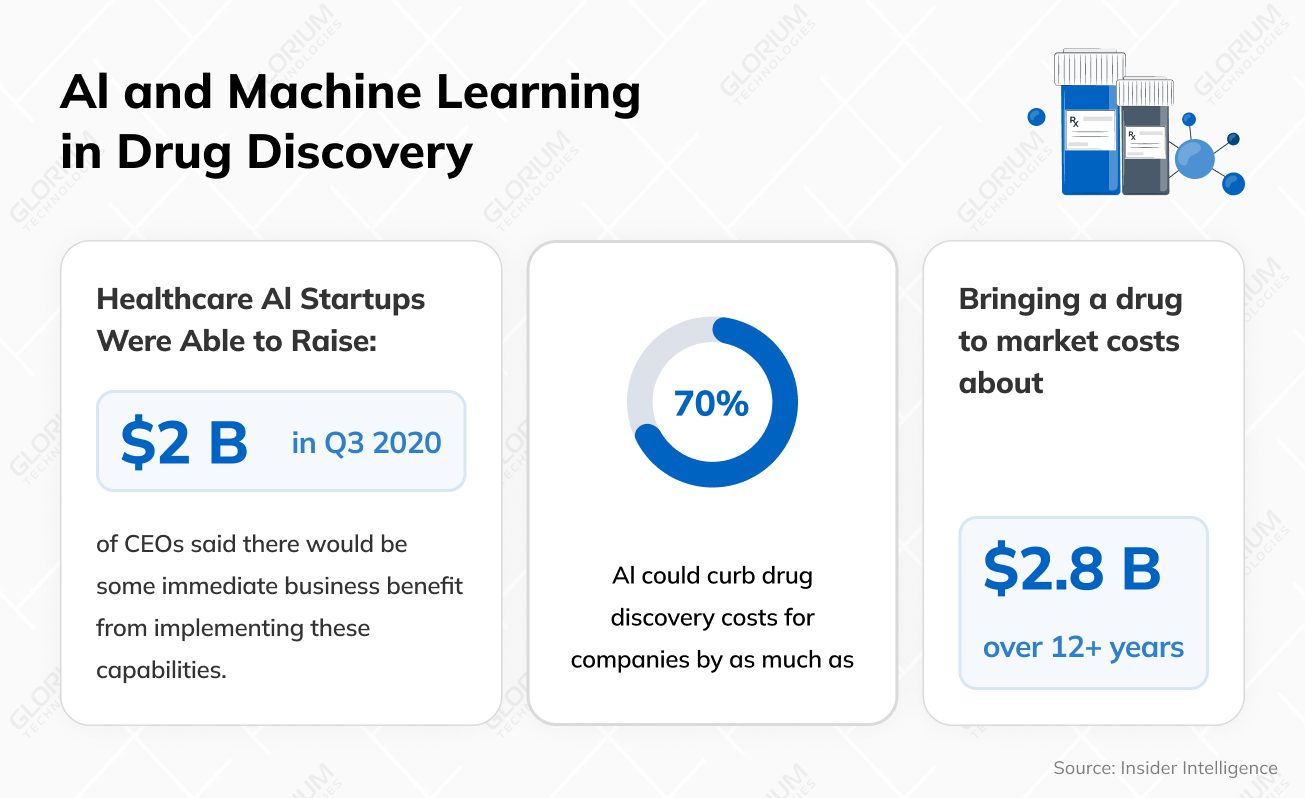
Healthcare providers can offer timely interventions by using automated AI diagnostics, which can speed up the identification of diseases and conditions. According to Grand view research, the use of AI in the diagnostic market is expected to grow in size.
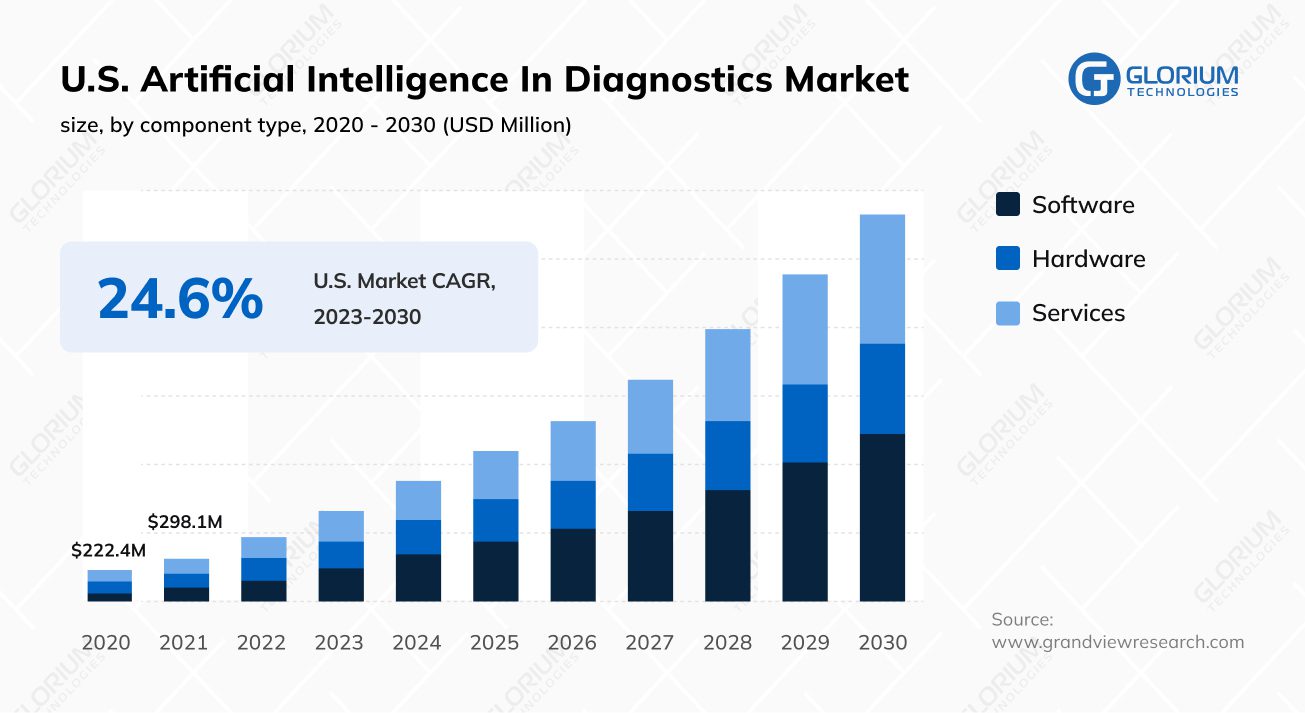
Predictive analytics can assist healthcare providers in offering targeted care by using historical data and machine learning algorithms to anticipate patient outcomes, such as readmission risks, disease progression, and potential complications.
The compound annual growth rate (CAGR) of predictive analytics in the U.S. healthcare market is expected to reach 23.2% by 2030.

To establish a thorough context, historical patient records, laboratory findings, past medication usage, and even information regarding patient lifestyle are analyzed by machine learning algorithms. By examining data points from the past, such as patient demographics, illness histories, and treatment outcomes, the AI system obtains a detailed understanding of potential future scenarios.
Advanced machine learning algorithms evaluate the data to detect correlations and patterns that may not be noticeable to human observers. These algorithms are often trained through “supervised learning,” a method where both input data and the desired output are provided, allowing the algorithms to “learn” from their mistakes and enhance their predictions as time goes on.
AI chatbots and apps can keep track of a patient’s vital signs and symptoms, and even provide simple medical guidance.
The healthcare chatbots market size is expected to reach $944.65 million in 2032.
![Healthcare Chatbots Market Size, 2023 to 2032 (USD Million] Healthcare Chatbots Market Size, 2023 to 2032 (USD Million]](https://b2461891.smushcdn.com/2461891/wp-content/uploads/2023/11/Healthcare-Chatbots-Market-Size-2023-to-2032-USD-Million-1.jpg?lossy=1&strip=1&webp=1)
AI advanced technologies are capable of monitoring various vital signs such as heart rate, blood pressure, and oxygen levels, as well as tracking symptoms over time. These technologies utilize machine learning algorithms and real-time data analytics to provide simple medical advice, which could be essential for early detection or managing existing health conditions.
We analyzed the revenue of leading healthcare companies and startups who have already used AI technology. The table provides revenue data for 38 healthcare companies and startups from various regions. The cumulative revenue from these companies amounts to $7,475.8 million.
Top 5 Revenue Earners (as a percentage of total revenue):
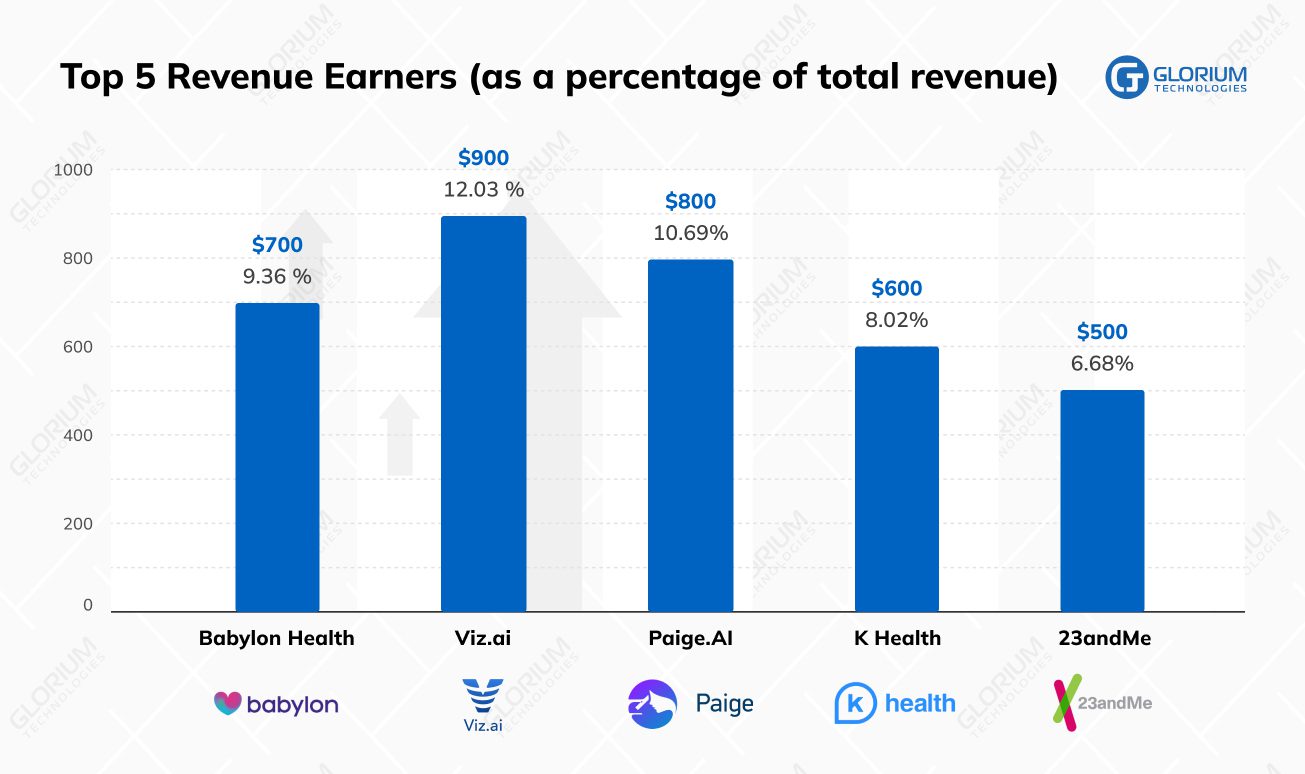
Country-wise distribution:
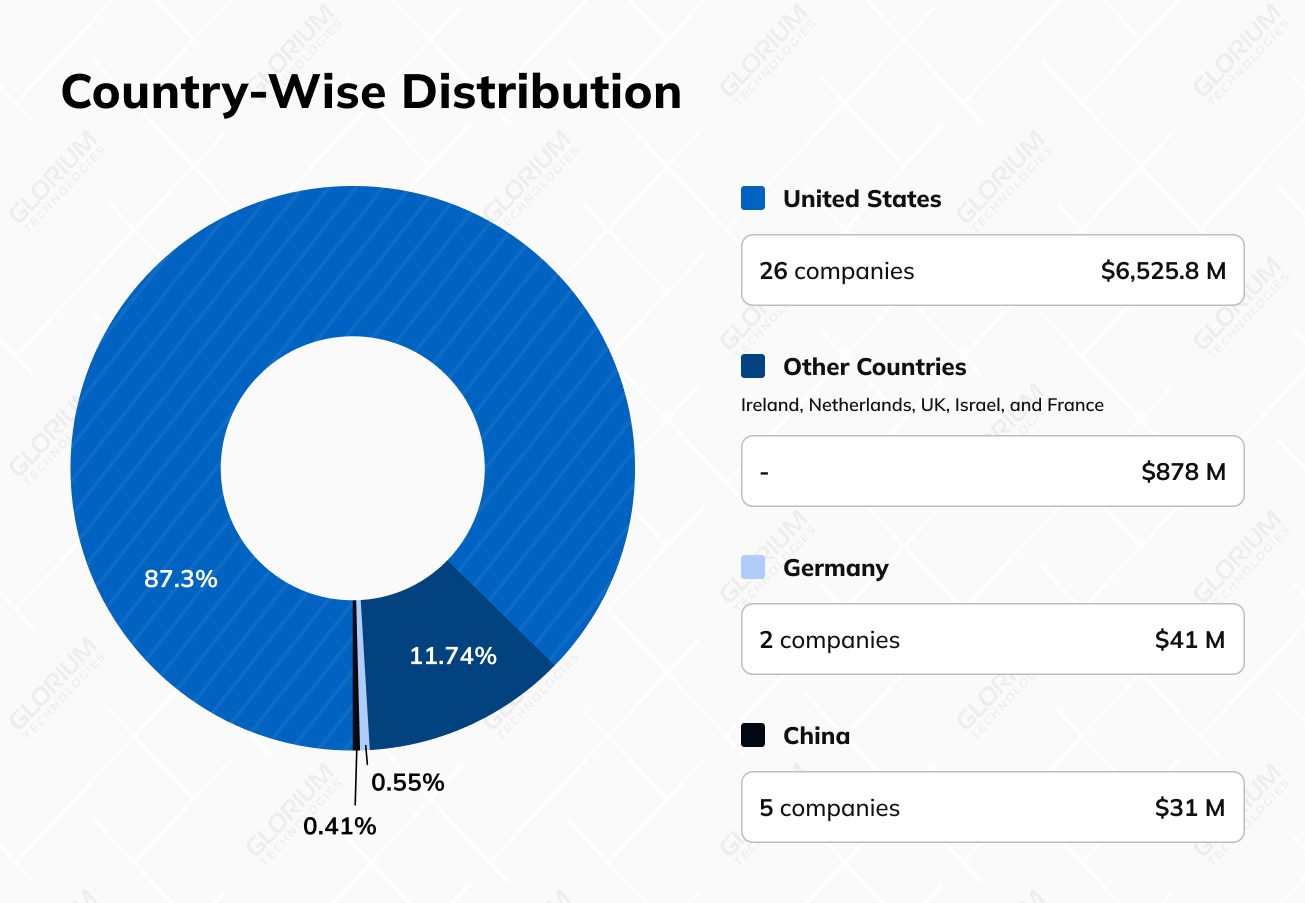
Diversity of business models:
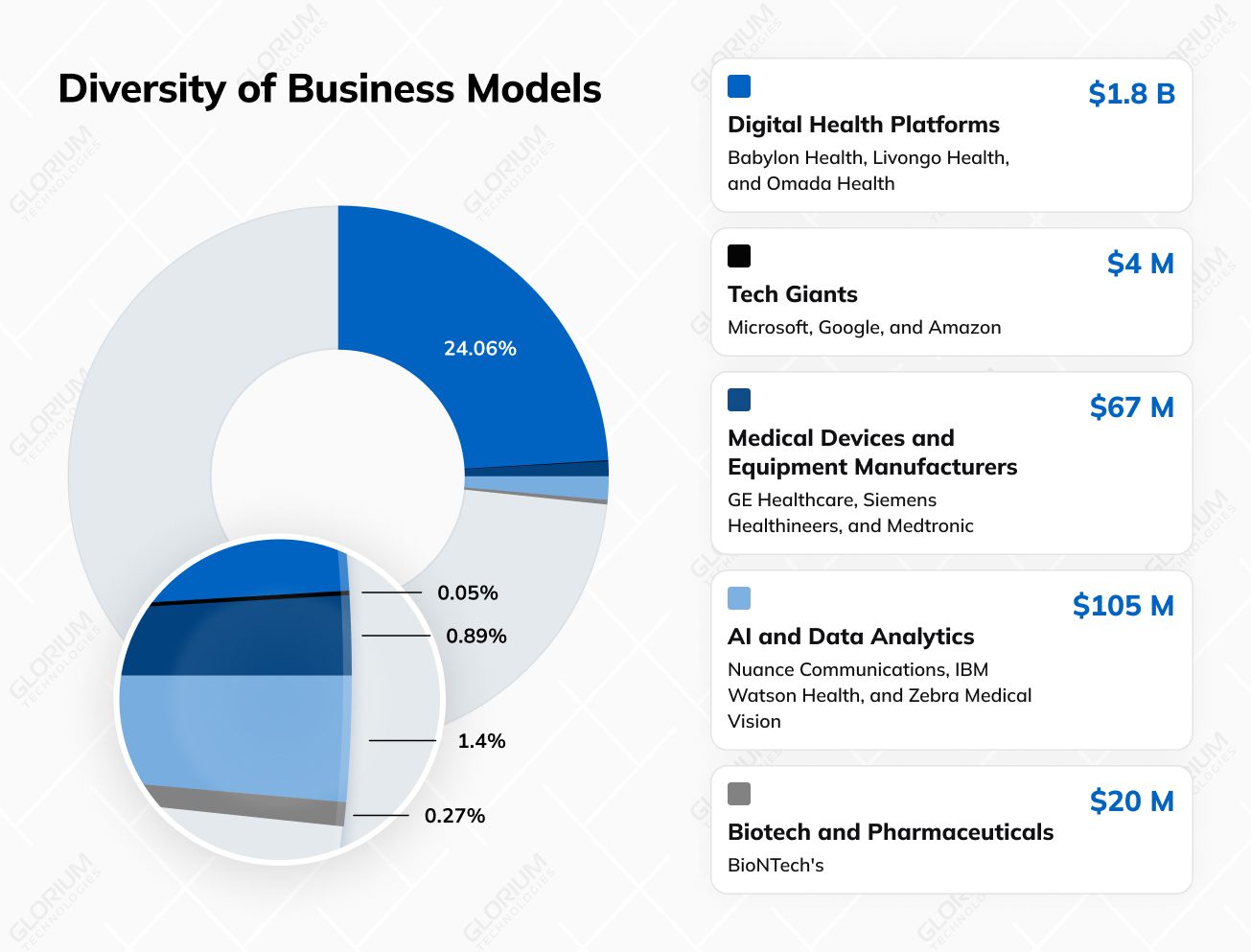
Analyzing the revenue percentages provides a clearer perspective on the dominance of specific sectors within the healthcare industry. U.S-based entities, especially startups and digital health platforms, significantly lead in revenue generation. However, the relatively smaller percentage contributions from tech giants hint at vast untapped potential. The ever-evolving synergy between technology and healthcare, demonstrated by these numbers, underscores the immense opportunities and the competitive landscape that lies ahead.
| Company | Revenue (in millions of USD) | Country | Source |
| Ping An Good Doctor | 10 | China | Ping An Good Doctor Annual Report 2022 |
| Alibaba Health | 10 | China | Alibaba Health Annual Report 2022 |
| Tencent Healthcare | 5 | China | Tencent Annual Report 2022 |
| Medtronic | 30 | Ireland | Medtronic Annual Report 2022 |
| Johnson & Johnson Health and Wellness | 14 | United States | Johnson & Johnson Annual Report 2022 |
| Siemens Healthineers | 21 | Germany | Siemens Healthineers Annual Report 2022 |
| Philips Healthcare | 18 | Netherlands | Philips Healthcare Annual Report 2022 |
| GE Healthcare | 16 | United States | GE Healthcare Annual Report 2022 |
| Nuance Communications | 2 | United States | Crunchbase |
| Amazon Health Services | 2 | United States | Amazon Annual Report 2022 |
| Microsoft Healthcare | 1 | United States | Microsoft Annual Report 2022 |
| Google Health | 1 | United States | Google Annual Report 2022 |
| IBM Watson Health | 3 | United States | IBM Annual Report 2022 |
| Ant Group Healthcare | 3 | China | Crunchbase |
| BioNTech | 20 | Germany | Crunchbase |
| Babylon Health | 700 | United Kingdom | Crunchbase |
| Verily | 1,5 | United States | Crunchbase |
| Flatiron Health | 1,2 | United States | Crunchbase |
| Tempus Labs | 1,1 | United States | Crunchbase |
| Viz.ai | 900 | United States | Crunchbase |
| Paige.AI | 800 | United States | Crunchbase |
| K Health | 600 | United States | Crunchbase |
| Livongo Health | 500 | United States | Crunchbase |
| Omada Health | 400 | United States | Crunchbase |
| Pear Therapeutics | 300 | United States | Crunchbase |
| Proteus Digital Health | 200 | United States | Crunchbase |
| 23andMe | 500 | United States | Crunchbase |
| Atomwise | 100 | United States | Crunchbase |
| Butterfly Network | 200 | United States | Crunchbase |
| CancerIQ | 100 | United States | Crunchbase |
| Huma | 100 | United Kingdom | Crunchbase |
| Insilico Medicine | 200 | China | Crunchbase |
| Nvidia | 17 | United States | Nvidia Annual Report 2022 |
| Owkin | 50 | France | Crunchbase |
| Precision Medicine Group | 100 | United States | Crunchbase |
| Quantum Leap Healthcare | 100 | United States | Crunchbase |
| Schrödinger | 100 | United States | Crunchbase |
| Zebra Medical Vision | 100 | Israel | Crunchbase |
| Zocdoc | 100 | United States | Crunchbase |
Many organizations need to increase their adoption or investments in AI and ML, with a majority intending to maintain or increase their investments next year. AI and ML are increasingly influencing technology purchasing decisions. However, there are many risks and obstacles preventing organizations from fully implementing these technologies, with data and security being the top concerns. Concerns about accountability and measuring ROI are also hindrances.
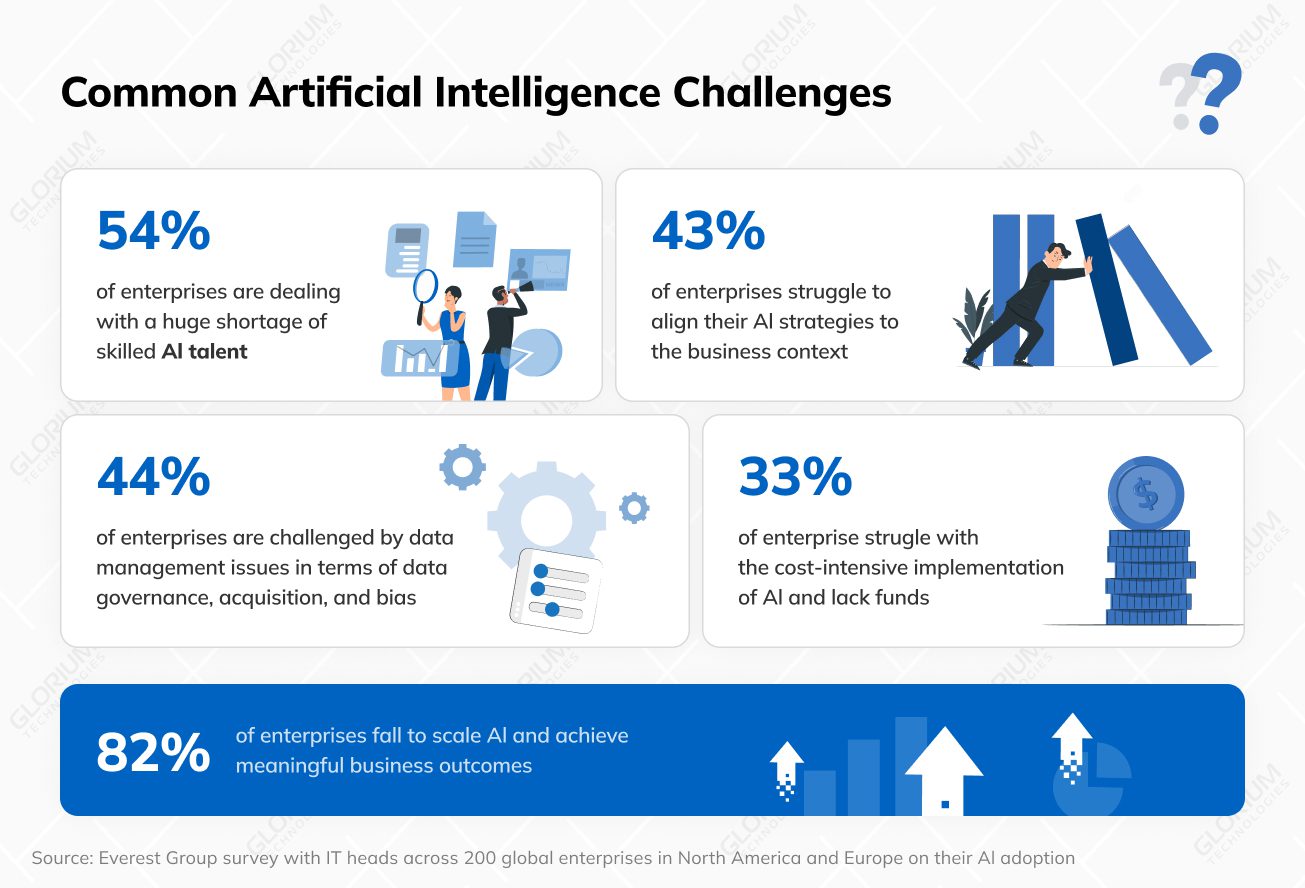
The timeliness and reliability of data are also a concern for many organizations, with some citing insufficient data volume or quality as a reason for AI falling short of expectations. Data security and privacy are also significant barriers to entry for organizations looking to utilize AI and ML. Despite these difficulties, many organizations believe that reducing risks would increase the uptake of these technologies.
Under growing demand:
Challenges and barriers:
Data concerns:
From the outset, AI deployment can boost revenue and generate immediate ROI by enhancing efficiency and refining marketing approaches.

In the nascent stages of a business, investors typically anticipate a 3 to 5 times return on their initial capital over a 5 to 7-year period. Fortunately, incorporating AI can enhance revenue and yield immediate ROI by optimizing operational efficiency and honing marketing tactics. You possess an innovative product concept, a passionate development team, and an unyielding ambition to actualize your idea.
What component is often lacking? Typically, it’s the financial support to morph your dream into a tangible entity. This is the juncture where investor capital becomes pivotal. Since 2022, the integration of AI has emerged as a vital element in attracting investor engagement, underscored by its potential for efficiency, customization, and scalability.

AI’s applications range from customer service-enhancing chatbots to personalized shopping recommendation systems and ultra-efficient databases that can swiftly sift through a vast amount of data. Its adaptability allows it to be incorporated across diverse sectors.


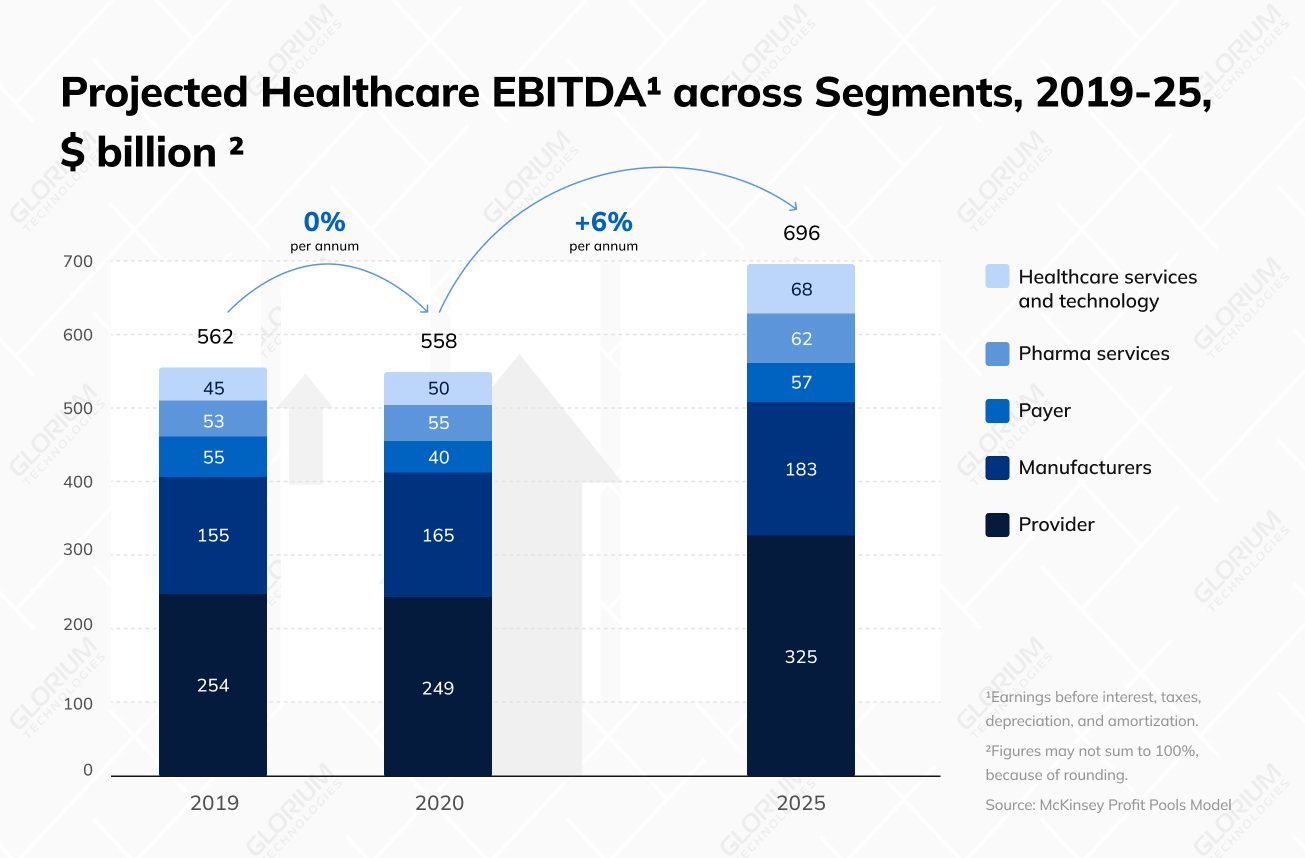
When showcasing to investors, emphasizing how AI accelerates diagnostic processes can make your product stand out as a pioneer in medical advancement.
Spotlight on AI’s ROI influence:
Raw data holds undeniable power. Illustrating the prospective ROI is instrumental in enticing investors. The monetary advantages of AI emanate predominantly from:
AI also shines in refining customer interactions. Companies gather, assess, and leverage consumer data from diverse sources to adeptly traverse the customer journey. This granular approach facilitates better customization in messaging, user experience, and personalization.
Take the e-commerce domain as an example: AI-driven product suggestions can escalate sales by aligning with a user’s purchasing history. This precision boosts conversions and augments revenue. Presenting data on how AI can magnify business ROI can substantially fortify your investor pitch.

Healthcare Services and Technology (HST): Sustained growth propelled by software and platforms.
HST has consistently showcased growth over time. Even during the pandemic, this sector flourished, with profits escalating from $45 billion in 2019 to $50 billion in 2021. The future looks promising as well. Forecasts suggest the segment will expand at an annual growth rate (CAGR) of 8.2% from 2021 to 2025, reaching approximately $70 billion by 2025. This growth trajectory positions HST to surpass the profit pool of payers by that year.

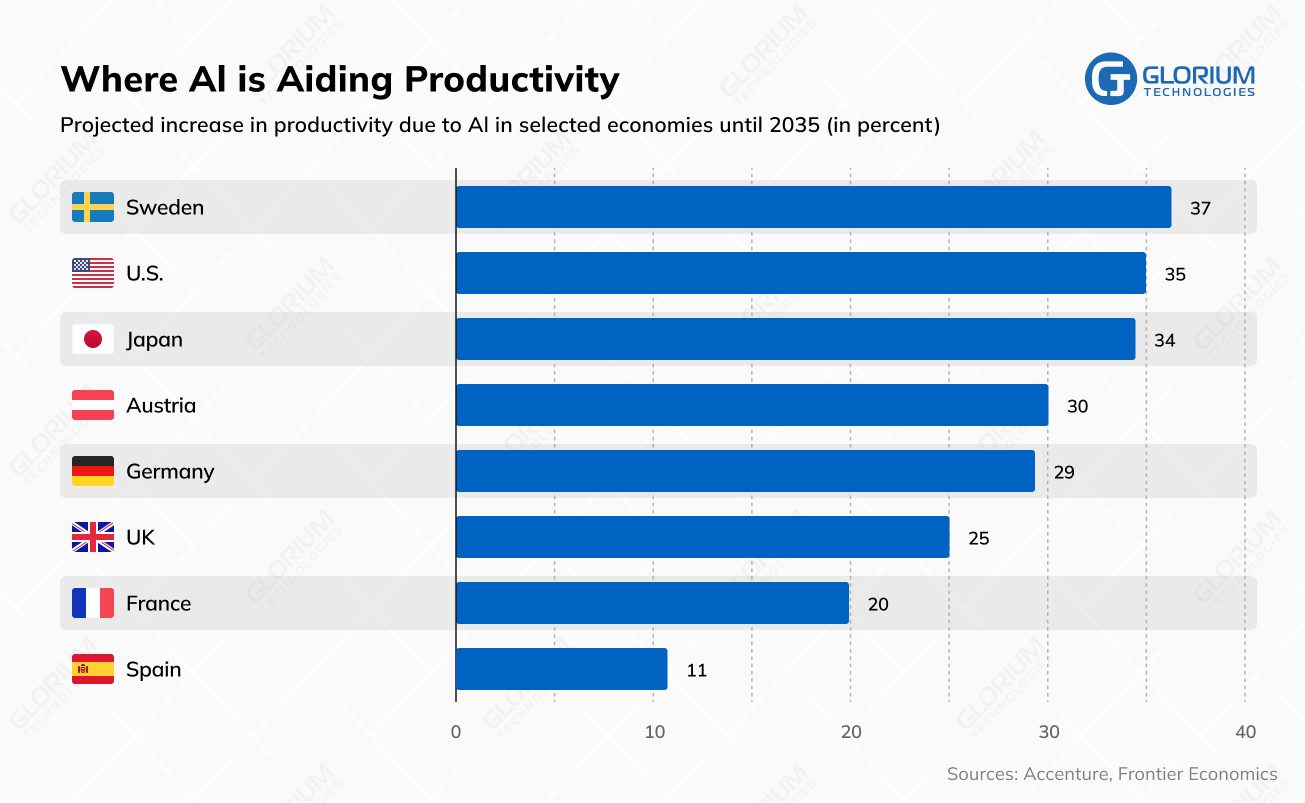

Our exploration makes it clear that AI’s imprint on healthcare isn’t just temporary or superficial; it’s foundational, steering the healthcare sector towards unprecedented realms of efficiency, precision, and patient-centricity.
Yet, the story of AI in healthcare is still being written, and its most significant chapters may lie ahead of us. As technology evolves, it will inevitably lead to innovations we haven’t envisioned yet. The real-time analysis, combined with AI-driven assistive tools, might soon become integral to every healthcare professional’s arsenal, from surgeons to therapists.
But, with every innovation and step forward, there’s a responsibility to harness and guide that power. And that’s where our call to action emerges, especially for startups. The healthcare landscape is vast, and the potential applications of AI within it are virtually limitless. With their agility, innovation-driven ethos, and ability to pivot rapidly, startups are in a prime position to leverage this potential.
However, harnessing AI’s power is more than just about integrating the latest algorithms or tools. It’s about understanding the unique challenges and needs of the healthcare sector, respecting patient privacy and ethics, and working collaboratively to ensure AI serves as an enabler, not a disruptor. AI’s real power in healthcare will be realized when it’s used to complement human expertise, not replace it.
The gauntlet has been thrown to every startup and visionary at the cusp of this revolution. The opportunities are vast, but so are the responsibilities. As pioneers in this space, it’s upon you to not just adopt AI but to do so with a vision that prioritizes patient well-being, ethical considerations, and sustainable growth.
Together, with the right intent, knowledge, and collaboration, we can shape a future where healthcare isn’t just efficient and advanced but also accessible, empathetic, and profoundly human-centric. The future beckons, and AI is the compass. Let’s chart this journey with foresight, responsibility, and Glorium Technologies innovation.


